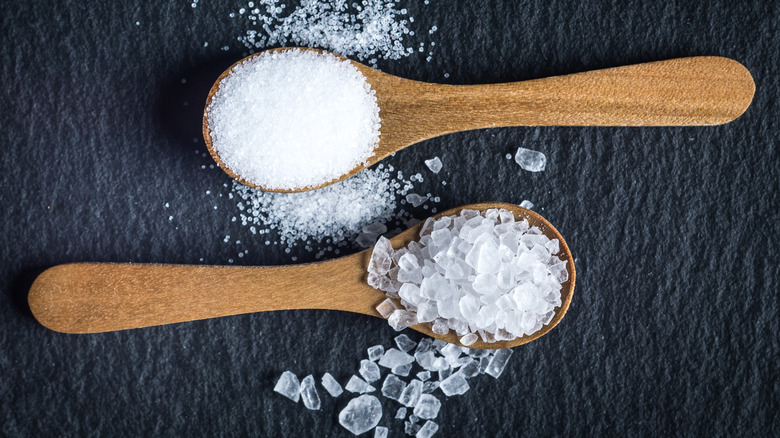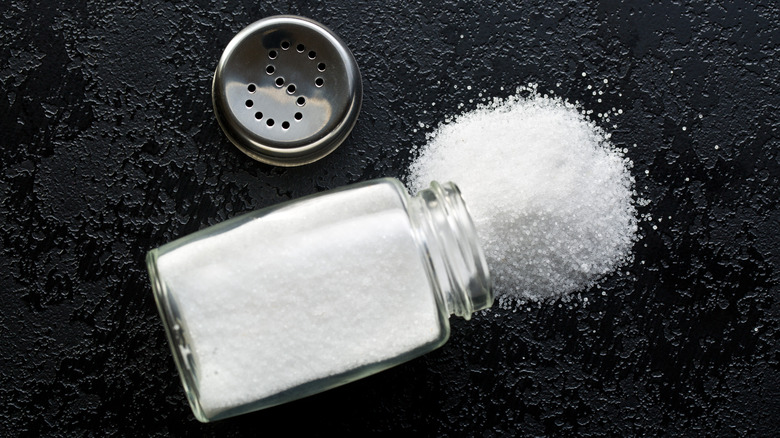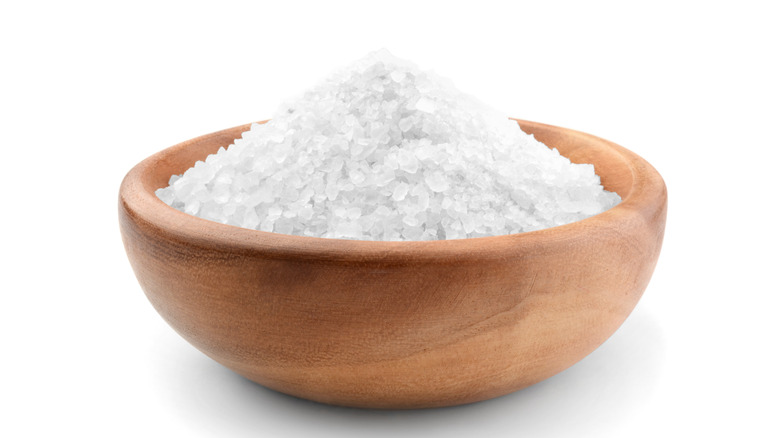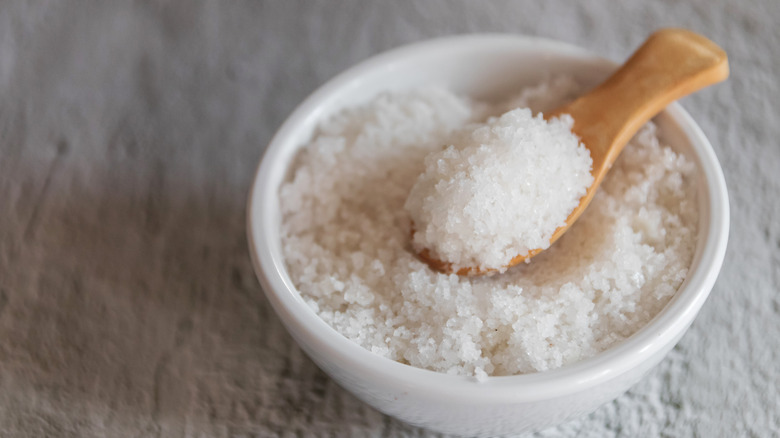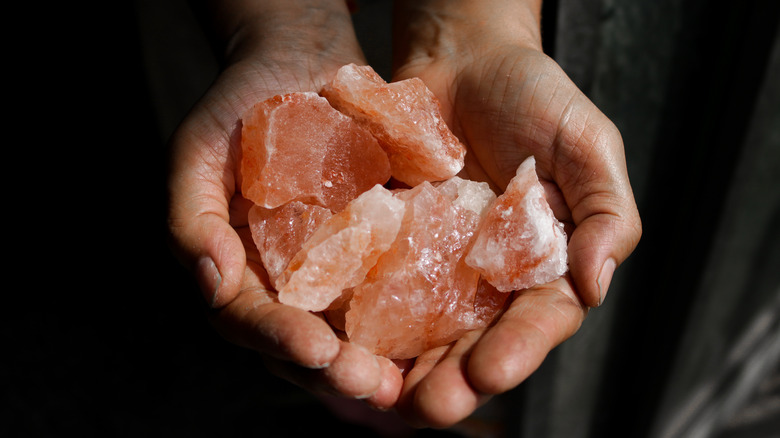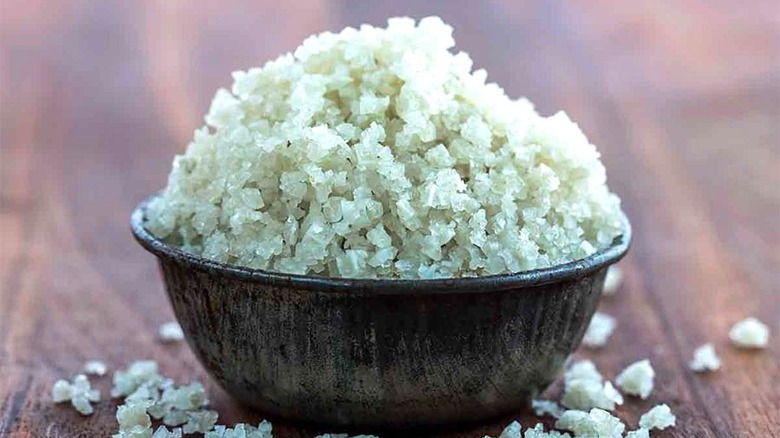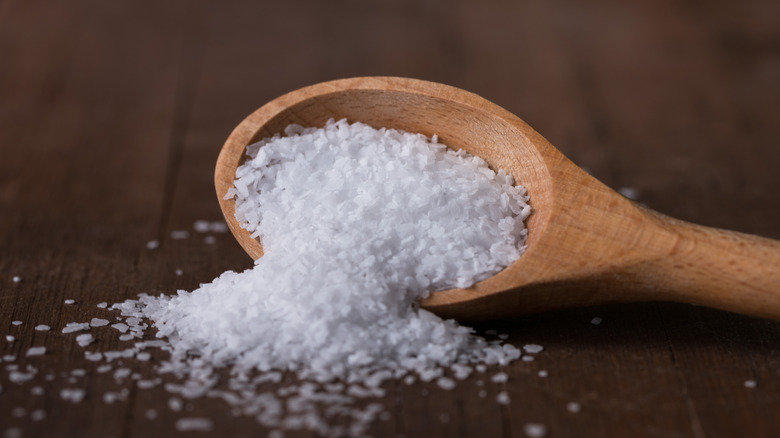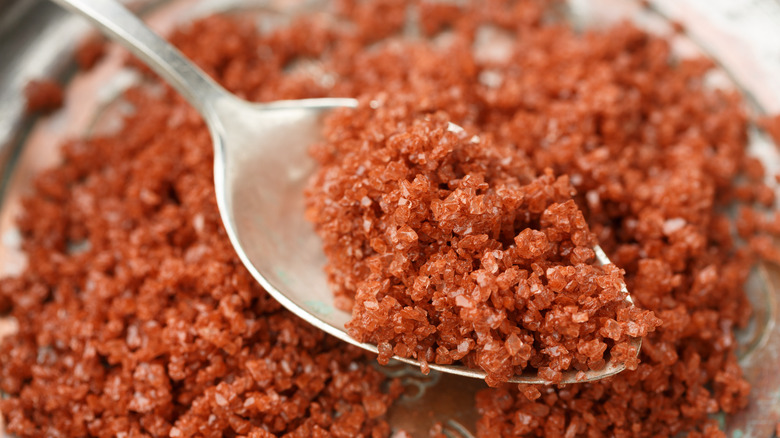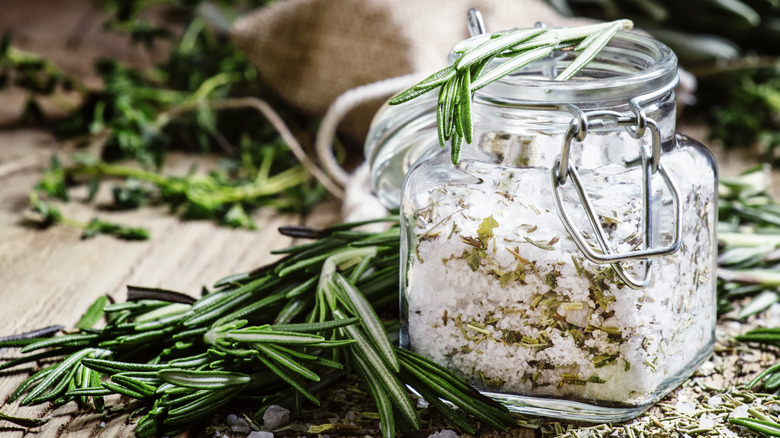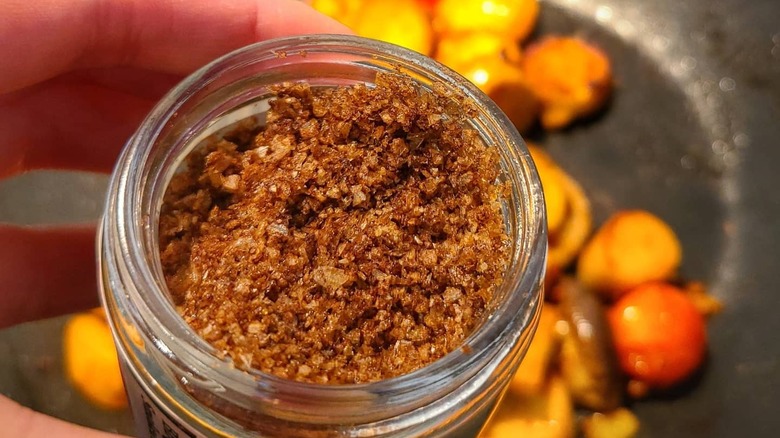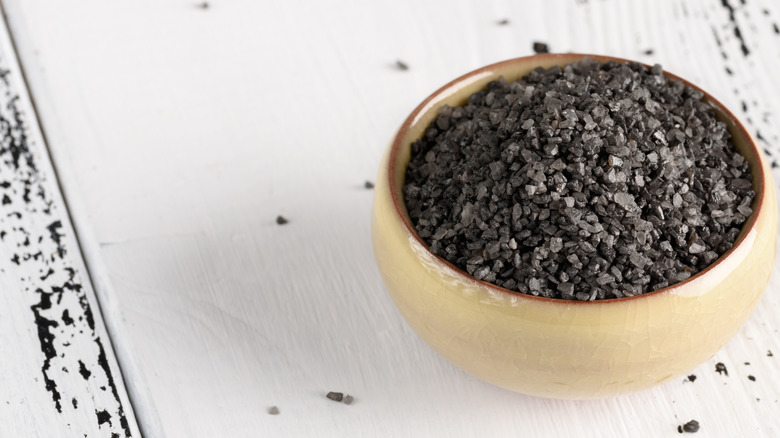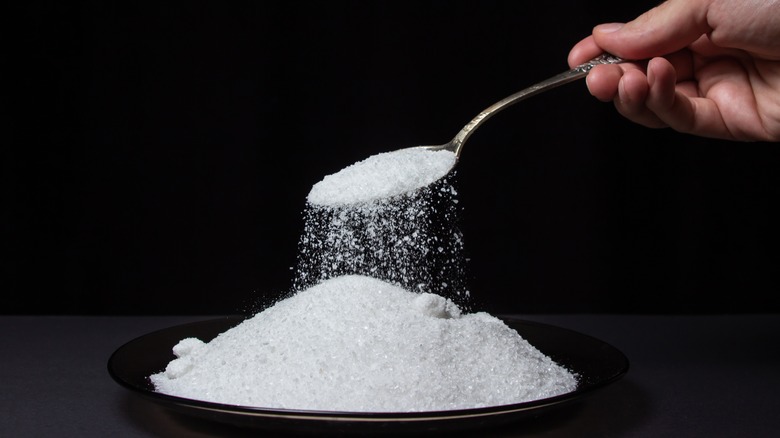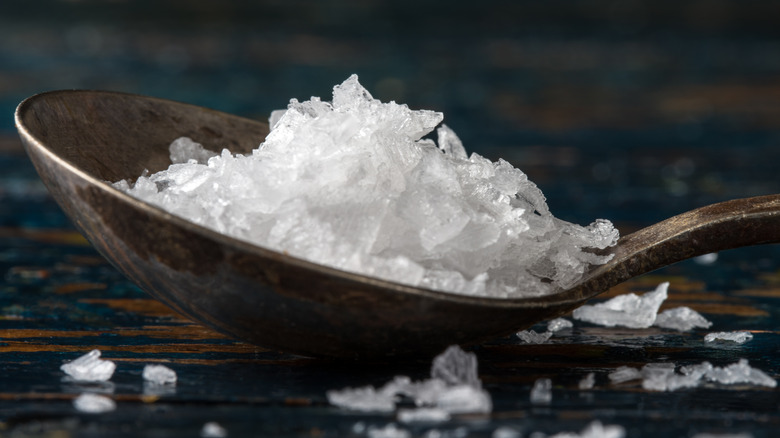12 Types Of Salt And How To Use Them
Salt is a simple chemical compound that makes a world of difference in cooking. Without a doubt, it is the MVP inside any spice cabinet. With just a pinch of salt, you can transform a bland, dull meal into a spectacular feast for all senses. The salinity balances all the flavors, provides an edge, and gives the dishes attitude. Although we often seem to ignore salt in favor of some stronger and bolder seasonings, the truth is that without it, no other element would be able to come through. It is a natural addition to every savory dish, but you will often need to add salt to desserts, as it is the only element that keeps all that sugar in check.
What we often ignore when it comes to salt is the sheer variety of different types around us. You've probably heard terms such as sea salt, kosher salt, or table salt, but there is much more to this salty mineral. This round-up will show you that not all salt is created equal, and when it comes to use, it seems that each type was designed for a particular purpose. As one of the essential cooking ingredients, these tiny flakes deserve much more attention and credit.
1. Table salt
Table salt is probably the most commonly used salt in the kitchen. It is also the most frequent salt option packed inside salt shakers. Though we often think of it as pure salt, there are several ingredients that separate it from other varieties. It's true that table salt is majority sodium chloride, that is, NaCL or pure salt, which can make up 97% to 99% of the mix, according to ThoughCo. But as salt tends to clump up, producers will also add small percentages of anti-caking agents that maintain a finer texture and keep the granules small and uniform. Most table salt is made from rock salt, though sea salt is also suitable. In the production process, the salt is usually purified and often amped up with other additives. Table salt typically contains a small amount of iodine (which is great for your thyroid), and fluoride and folic acid are also sometimes added to the mix.
Table salt is versatile, readily available, and has many functions in the kitchen. Really, you can just add it to anything that calls for or is in need of some added saltiness. Though you won't often see it listed as the highest quality salt on the market, it does have some advantages. The tiny salt crystals will allow the salt to blend and dissolve fairly easily, and you can better control the distribution of the crystals because of their uniform size (think measuring for a recipe). Many believe sea salt is healthier because it contains less sodium than regular table salt, but as Michigan State University explains, the two varieties actually have the same amount of sodium by weight.
2. Sea salt
As the name suggests, sea salt is a type of salt that is derived from the sea. This is the usual technique in warm climates with plenty of sunshine, and the process involves drying out seawater in shallow pools. As the sun heats these shallow patches of seawater, the water will slowly evaporate, and all that will be left when the pool is completely dried out are the flakes of sea salt dispersed across the salt bed. This is the old-school technique and the most natural way to extract salt from seawater, but some coastal countries don't have such favorable climates, so they rely on different methods, such as applying heat, to enable the liquid to evaporate.
Sea salt has multiple uses in the kitchen. You can always use it as a finishing salt to lightly sprinkle on the dishes before serving. It would work with proteins or vegetables. As a finishing option, sea salt will deliver salinity, but as it has slightly larger flakes, it will also provide some texture and crunch. Sea salt is also suitable to add to sweet dishes or savory dishes that are not packed full of flavor. This is the salt that carries that natural mineral note, but it's not overly salty, so pair it with subtle flavors and allow it to shine through other components.
3. Fleur de sel
Fleur de sel (flower of salt) is a unique and rare type of salt that falls into the broader category of sea salt. It can only be produced with the old-school technique of drying out shallow saltwater pools. As the liquid from the water evaporates, salt crystals are left behind, and, if the weather allows it, they will stay on the surface without touching the bottom of the pool. In this way, the crystals remain intact and retain a spotless white color. Fleur de sel is harvested by hand. It is a superior type of salt that is not processed and doesn't contain additives, and as such, it usually commands higher prices.
You will rarely add fleur de sel to stews or soups, where the delicate nature of this salt would be overpowered and lost in the flavor mélange. It would provide saltiness, but as we're talking about one of the finest salt varieties, you want to preserve its subtle character and allow it to shine through — and the best way to do that is to add it at the end as a finishing salt. Sprinkle fleur de sel on any dish right before serving, and you will be able to appreciate the nuanced flavors. Fleur de sel works well with both savory and sweet dishes, and a small amount will go a long way. If you're looking for the best quality finishing salt, fleur de sel is the safest and the most reliable choice.
4. Himalayan pink salt
Himalayan pink salt is a unique salt variety mainly harvested in Pakistan. The name is a reference to the light rosy hue resulting from a unique combination of minerals found inside the crystals, along with sodium chloride as the dominant element. The salt is extracted by hand from Khewra Salt Mine. It is not usually altered with additives, but it is cleaned to remove all unpleasant grub and impurities. You will find Himalayan salt in a familiar flaky form standardly used in cooking, or in the form of pink blocks that can be heated or frozen to maintain warm or cool temperatures of the dishes. These pink salt slabs will also deliver subtle saltiness to whatever is served on them.
Himalayan pink salt is perhaps best used as a finishing salt. The slightly larger crystals will perfectly season any savory dish, while the light pink hue will add an aesthetically-pleasing touch. As the flakes are larger than standard table salt, they provide some texture and crunch too. Himalayan pink salt can also work in desserts, especially if you want to add just a sprinkle on top of your favorite brownies, citrusy sweets, or chocolate chip cookies. Even if you've never seen this pink-colored salt on your dining table, you might have come across salt lamps. The lamps are made with Himalayan salt blocks and are simply hollowed to fit a light bulb.
5. Sel gris
Sel gris, or gray salt, is closely related to the previously mentioned fleur de sel, and the two are actually created during the same process. Just like the fleur de sel, this gray variety is obtained from evaporated seawater. As the heat helps the water to evaporate, the salt crystals are naturally eliminated and left behind. Fleur de sel is the finest version you will get in the process, but sel gris doesn't fall too far behind. Rather than floating on the surface like fleur de sel, the crystals used for sel gris fall to the bottom of the shallow pools. In this process, they attain a light gray hue — hence the name. The final result is an all-natural salt that has a subtle flavor and is generally classified dense, moist salt, meaning that you will probably need to add smaller amounts when compared to other kitchen salts.
Sel gris would be a welcomed addition to any meal and a fantastic finishing salt. The salt crystals are usually moderate in size but still slightly larger than those in regular table salt. As it comes from the sea, you can expect this salt to add a touch of mineral taste, along with natural salinity. The crystals can dissolve well, but if you just use a sprinkle on top of vegetables, meat, or fish, they can also deliver some texture and crunch.
6. Kosher salt
Kosher salt is a slightly misleading term used to denote a specific type of salt that was certified and approved by a Jewish governing body. The certificate would ensure that the product was made following strict dietary requirements and would classify it as suitable for a traditional Jewish diet. However, this type of salt proved to have potential outside the Jewish community. The phrase kosher salt is now liberally used for many types of unprocessed large-flaked salts, but it doesn't mean that every batch is produced following the kosher law. Most kosher and kosher-style salts come from salt mines, and unlike regular table salt, they don't usually include additives or anti-caking agents. It is a natural, not heavily processed type of salt that is promising in the kitchen.
Kosher salt has larger flakes, a distinction that visually separates it from table salt. This texture was primarily conceived as these larger flakes do a better job removing all the moisture from the meat, which is in line with kosher dietary laws. Besides being natural and additive-free, kosher salt is easy to handle and dose because it's clearly visible on whatever food you sprinkle it on. Additionally, kosher salt is much better suited for cooking than for baking.
7. Hawaiian sea salt
The term Hawaiian sea salt is usually used as a reference to what is colloquially known as alaea salt, a unique salt blend that is made with hand-harvested sea salt mixed with local volcanic clay known as alaea. The clay provides a distinctive brick-like color to the blend, and it packs several natural minerals typically found in volcanic clay soils. It can also slightly influence the aroma of the salt to add just a touch of earthiness.
Alaea salt is versatile, so you can freely add it to any dish, but it can also do a great job as a finishing salt. It usually has a slightly coarser texture than regular table salt, and you might find it more delicate with a mellower flavor that is also clear and bright. The addition of clay will deliver subtle earthy nuances, but they should not be overpowering. Hawaiian sea salt is not easily found in your local supermarket, but you can source it from specialized or gourmet web shops. This salt is often featured in some traditional Hawaiian dishes, such as poke and kalua pork, but apart from its use in the kitchen, alaea salt is a big part of local rituals, as it is believed to have purification properties.
8. Flavored salt
Unlike other salts on this list, flavored salt does not fall under one clear category. It encompasses a wide variety of salt blends that are flavored with various ingredients. The base is always salt, though it can be derived from numerous sources across different locations. However, there are some regional preferences regarding the exact ingredients added to the mix. Flavored salt can be a simple affair with only one added component, but it can also be a flavor-packed beast with dozen or more additions. Most of these will be completely natural, mainly derived from herbs, veggies, or other spices.
One of the most common salt blends incorporates dry herbs. This salt will always have a slight Mediterranean feel, especially if it's made with sea salt and includes classic Mediterranean herbs such as thyme, rosemary, or mint. This type of flavored salt is very versatile and easily adaptable. You can use it for most savory dishes, and it will add a nice touch as a finishing salt, especially in dishes inspired by this region's cuisine.
Other common flavored salt varieties that are readily available are garlic salt, spicy salts, and salts infused with dried veggies or citruses. Sometimes, these can be quite strong, so make sure to be intentional with which salt you pair with which ingredients. If you want to let them be the star, use them generously as a finishing touch on anything from steaks and fish, to pasta, risotto, and potatoes.
9. Smoked salt
Smoked salt could be classified as a type of flavored salt, but as it's such a unique variety, it deserves to have its separate mention. As the name suggests, this is a type of salt that has been infused with smoke. The process is simple and involves smoking the salt over slow-burning wood, allowing the salt crystals to gradually attain all those deep, smoky aromas and flavors. The final profile of this salt will depend on the type of wood. You will often see chicory, oak, mesquite, and applewood, but any other variety that is generally good for smoking can be used in the process. Smoked salt will, of course, deliver those distinctive smoky notes to any dish.
We often think of this salt as a perfect accompaniment to meat dishes, and though it has an ideal partner in meat, smoked salt can also nicely complement various vegetables. You can easily incorporate it into any savory dish, but you will also find it useful as a condiment lightly sprinkled over toast, eggs, or potatoes. This salt is also a superior option for marinades and rubs. For the best quality, make sure to find a variety that has been smoked with real wood. This version will have the most subtle characteristics and won't appear harsh and too intensive. Artificially smoked salt will be classified as "flavored," and might have overpowering synthetic woody notes.
10. Black salt
Black salt can be used as a reference for two different salt varieties. One type of black salt comes from the Himalayan region and goes by the name kala namak. This is a salt harvested from regional salt deposits, and you will mostly encounter it in Indian and Pakistani cuisine. Himalayan black salt usually has large crystals and a rough, coarse texture. The flavor is naturally salty, but it is easily distinguished by its aroma. You will often find sulfur notes as the content is usually enriched with hydrogen sulfide. The color of the salt is not pitch black as the name might suggest, and it's better described as dark brown with some deep pink or purple hues. Due to its characteristics, this is not your everyday salt in Western cooking, though some like it on eggs to really enhance the flavor.
Black salt is also used to describe dark-colored salt that usually comes from Hawaii and Cyprus. This variety is not naturally black but infused with active charcoal. You would want to use this salt as a finishing touch, lightly sprinkled right before serving. The charcoal might not add much flavor, but the salt makes a pretty impressive sight. You can also use it for decoration and coat the rim of cocktail glasses. This salt is often referenced as lava and volcanic, but it often has no such origin and relation to volcanos.
11. Pickling salt
As you may guess from the name, pickling salt is a type of salt you would add to pickled products. There are various pickling techniques, but the most common include salt curing to extract moisture or submerging ingredients into acidic solutions — vinegar usually does a perfect job here — that are generally amped up with a generous amount of salt. Of course, there are other pickling styles that depend on regional traditions or simply on your preferred choice. The examples range from very acidic versions that are thoroughly salty and savory to lightly briny styles with a subtly sweet flavor. The main ingredients vary, though fruits and veggies are the most frequent choices for pickling. Spices and herbs are commonly added for flavor, but they can be left out. However, in the traditional pickling method, salt is usually non-negotiable.
To get the best results, it is recommended to use a special pickling salt that has no added ingredients and is as natural as it can be. Kosher salt or sea salt could be suitable replacements here, but table salt should be avoided as it includes some chemical compounds that will make dissolving slow and complicated, and it has the potential to turn the brine into an opaque, murky mess. On the other hand, pickling salt quickly dissolves and keeps your brine crystal-clear, regardless of what is inside the jar.
12. Flake salt
Flake salt is a salt variety known for its shape. As you may have already guessed, the salt crystals in this salt come in a flattened form. Flat salt flakes are not how salt crystals form in nature, and they have to be mechanically produced. In the standard salt production process, salt minerals will typically have an irregular shape and undergo further processing to get the uniform-sized crystal. In the case of flake salt, the crystals are pressed until they turn into a thin, flattened flake.
Flake salt is not (yet) standard in home kitchens, but it might be the superior salt version that we should incorporate more often. As these crystals are thin, they will quickly melt in contact with heat, which makes dissolving a breeze. The flakes are also better at sticking to food, thanks to their flat shape and larger surface area. This might is especially useful when pre-seasoning steaks or fish. The texture is gentle and delicate, making flake salt the ideal finishing salt too. It delivers a subtle salinity that does not overpower the dish, and would certainly do a superior job as a light garnish on desserts. The thin, elegant crystals on top will also add an aesthetic touch and turn any dish into a stunner.
